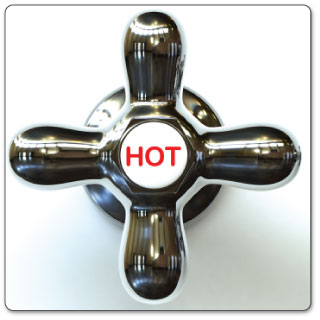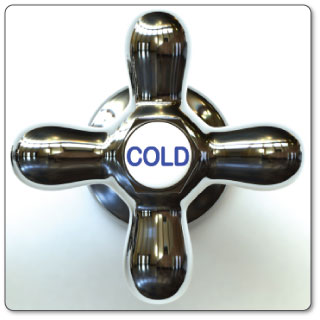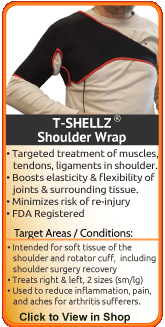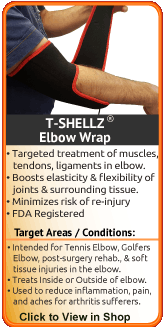|
| Ice vs Heat for Treating Rotator Cuff Tendinitis/TearsCombining cold and warmth is a simple yet effective way to get immediate pain relief and promote long-term healing. In your lifetime you've probably had your mom, family doctor, nurse, surgeon or physical therapist tell you to use ice right after you're injured and something warm from time to time once the swelling's gone down. It's a simple yet very effective way to relieve pain and promote healing in your shoulder. A rotator cuff tear can happen to anyone, and right now there are thousands of doctors and PT clinics dealing with patients that require a solution to their shoulder injury fast and heal it (where possible). If you want to be proactive about properly dealing with your bad shoulder, speak to your doctor about adding conservative temperature treatments to your recovery with AidMyRotatorCuff's system using a Cold Compress or Ice Pack and Circulation Boost with a Shoulder TShellz Wrap. Note: If you have an Acute (recent, inflamed) Soft Tissue Injury, Do Not Use Heat.Your doctor knows that the sooner cold is applied, the quicker you can reduce inflammation and achieve real pain relief. This will help reduce the chance of a much longer lasting chronic injury. Heat and inflammation are a bad mix and should not be used together. Heat is good at the spa - it will help your body relax, but when it comes to a swollen injury it is not a good idea, unless your physician specifically recommends it. When To Use Cold:A Cold Compress or Ice Pack work best to relieve pain, swelling and inflammation for new injuries, re-injury and during immediate post surgery recovery. A Cold Compress or Ice Pack should also be used during the first 24 - 72 hours of treatment, combined with resting your injury. Generally speaking, cold is recommended:
When to use a Shoulder TShellz Wrap (HEAT):
Here Are A Couple Of Examples For When To Use Cold (Ice) Or Heat:You have a Persistent Rotator Cuff Injury That Has Been Around for About 7 MonthsYou're having a "good day" (your injury is feeling fine) and decide to head out for some grocery shopping. You realize afterwards that was a bad idea because your shoulder is throbbing and even more painful than the day before. Use COLD on your shoulder to stop further damage to the tearing in your rotator cuff and help ease the pain. You've suffered from a rotator cuff tear a year ago, but haven't had felt any pain or twinges for the last 6 months.Now you're in the kitchen making a cup of tea and reach in your cupboard to get a mug. You forgot about your injury but realize it's there when you raise your arm and feel pain in your shoulder... Reaching for that mug just reminded you about your injury with a sharp pain / twinge. You stop and ask someone else to retrieve the mug for you (you stopped the activity that will cause more tearing in your shoulder). The pain was temporary and is now gone which means NO cold compression is needed. In this case heat via a TShellz Wrap® should be used to encourage blood flow to the shoulder. Use cold after any sort of activity causes you on-going pain.When Should You Use A Shoulder TShellz Wrap® On Your Shoulder?Circulatory Boost treatments work best to increase blood flow circulation and relieve pain for older (chronic) injuries, re-injuries (after swelling has been reduced) and during long-term post surgery recovery. Circulatory Boost should not be used directly after an injury, as you must wait for swelling to drop. Circulatory Boost treatments should not be started for a least 2 weeks after surgery because inflammation levels will be very high as the healing process starts over again. Any use of a TShellz Wrap® should also be combined with gradual movement to stretch out your shoulder and increase range of motion. If you have a chronic shoulder injury that keeps getting re-injured you should use a Shoulder TShellz Wrap before activity to loosen up your tissue (making it more flexible). This treatment is shown to increase the elasticity (flexibility) of the soft tissue in and around the treatment area, making it more pliable for activity and less likely to re-injure. Sometimes we feel pain while doing a certain activity - should you still use a TShellz Wrap®? Using a TShellz Wrap in the morning before you start your day or before activity can help to boost blood-flow and reduce risk of further strain or injury. Use cold part-way through your day after you have been active so you can decrease pain and inflammation from the flare up. Using a Shoulder TShellz Wrap® is a good long-term plan because it will help stimulate healing and can also be used on a preventive basis to relax constricted soft tissue. The use of a TShellz Wrap® indirectly enhances the local blood circulatory system, increasing the supply of oxygen and nutrients - the energy your tissues require to heal. What Makes the Shoulder TShellz Wrap Different?With regular use of the Shoulder TShellz Wrap®:
Our high quality wraps are registered with the FDA as medical devices which meet high manufacturing standards. How to Use Ice and Heat to Relieve & Treat Your Rotator Cuff When it comes to using ice and heat for treating a torn rotator cuff, it's important to keep in mind that both ice AND heat are very effective ways to relieve pain and heal. Most people will think one is better over the other from their own experience or what a doctor / physical therapist has previously told them. The only difference between using ice and heat is that 1 is better for you at a specific time in your healing cycle. Ice is used first, right when you get your injury, to decrease pain / swelling and inflammation. Once swelling has reduced, we then focus on heat based treatments to increase blood flow circulation in the area which will stimulate the body's healing response.  Each temperature treatment has its own unique benefits for the rotator cuff, and when used together (not at the same time!) they provide a powerful advantage to long-term healing. You may already know that ice or heat feels better on your shoulder, and this could influence your decision too. The bottom line is that ice and heat are exceptional, natural, pain relievers and healers for your rotator cuff injury. How Do You Use Ice / Cold as Pain Relief for Your Rotator Cuff Injury? COLD (ice) is used to treat injuries or conditions that are red, hot, inflamed, swollen and suffering from tissue damage (a tear or recovering from surgery). Cold is a natural / organic pain reliever that numbs pain right at the source of your injury. While doing this, the cold also stops cellular break-down and reduces the amount of scar tissue forming (this is very important after surgery). When cold is applied to a rotator cuff injury, all of the soft tissue in the shoulder will squeeze on the veins to slow down your blood flow. This in turn clamps down on the amount of fluid leaking into your injured tissue, decreasing your swelling. This is why cold is used immediately to treat newer shoulder injuries or re-injuries. The cold slows down your body to stop the amount of damage happening to your tissue and decrease your swelling. This cold also has a nice side benefit of numbing the nerves in and around your rotator cuff thereby decreasing your pain. In the medical world this is something called 'Vasoconstriction'. Cold can Make Your Rotator Cuff Injury Worse - How? Applying cold can restrict blood flow and stiffen / tighten soft tissue. Cold is NOT a good treatment method for your rotator cuff tear when the tissue is already tight and constricted, because the cold will just stiffen the tissue further. Instead use a treatment that will increase blood flow, like the Shoulder TShellz Wrap® (Circulatory Boost), to relieve any spasms in your rotator cuff and relax / elongate your tissue making it much more pliable. When to Use a Cold Compress or Ice Pack to Treat Your Rotator CuffCold compression works best to relieve pain, swelling and inflammation for new injuries, re-injury and during immediate post surgery recovery. Cold therapy should also be used during the first 24 - 72 hours of treatment, combined with resting your injury. If you've been suffering for some time with a chronic rotator cuff injury you should only use cold after activity causes you more pain or triggers more inflammatory response symptoms (red, hot, inflamed, swollen).. This would be when your shoulder starts to hurt at the end of the day after you've been using your arm for normal, daily tasks the entire day. When used at this time cold compression becomes a natural / organic pain reliever, treating the site where you feel the pain. Sometimes we feel pain while doing a certain activity - should you still use cold? Too much cold therapy can reduce your ability to heal correctly, because cold is a short term pain reliever not a deep tissue healer. Cold Therapy slows nerve and tissue function - reducing swelling that blocks blood vessels from doing their job. This is important because once blood vessels are blocked or damaged, they can no longer carry oxygenated blood through the tissue and tissue begins to break-down. Without cold therapy, tissue damage and break-down continue as they cannot get the oxygen they need to survive. By limiting the amount of damage done to your shoulder, you also limit the amount of healing that needs to occur. This is an important step to heal rotator cuff injuries faster and with less pain! How Do You Use a Shoulder TShellz Wrap® (Heat) HEAT (warmth) is used after you've reduced your swelling / inflammation and the sharp pain is less intense (you have more of a dull / nagging ache and soft tissue tightness in your shoulder). Warming up your tissue is a natural way to encourage blood flow to soft tissue. Increasing the temperature of soft tissue will result in increased blood flow circulation. It's the blood in your body that will bring oxygen, nutrients and water (basically energy) to your injured shoulder to help with healing. When heat is applied to the rotator cuff, your veins will start to get bigger (expand) to allow more blood flow through to your damaged or torn soft tissue. This in turn relaxes the area, making the tissue more flexible and elastic. This is why heat is used on older (chronic) injuries, to loosen soft tissue and bring in the blood flow needed for healing. Your body will begin to heal itself after it is injured - increasing your blood flow with heat will actually help accelerate this natural process. Doctors usually call this process 'Vasodilation'. Heat can Make Inflammation, Swelling and Newer Injuries Worse - How? When we injure ourselves, we start healing right away. The body will naturally raise the temperature at the site of the injury resulting in the inflammatory response (redness, heat sensation, inflammation and swelling). This 'fake fever' leaks blood flow to the area to cool it down and start the healing process. Adding 'heat' to your shoulder when it's already inflamed and tender may make your body think there's a new threat to your tissue and increase the pain in order to get you to stop. For some people applying heat on inflamed / swollen tissue will cause the injury to swell-up even more (as much as 3 times larger than normal). You'll feel even more pain as the pressure builds in your shoulder. Heat is NOT a good treatment method for inflamed rotator cuff injuries, new injuries (within the first 24 to 72 hours), right after surgery or right after a re-injury (over-use and/or sharp, throbbing pain). In these cases, heat should be applied later on in the healing cycle, once swelling has reduced substantially. In the meantime, use a Cold Compress or Ice Pack to decrease any inflammation induced pain. When To Use Heat to Help Your Rotator CuffThe primary intent of a heat based application is to increase blood flow circulation and, as such, stimulate the body's recovery rate for older (chronic) or recent (acute) injuries, long-term post surgery recovery and more recently - for some regenerative therapies performed by doctors and PTs. Warmer temperatures should be used approximately 3 to 5 days after you first have the injury or even later if the swelling has not reduced significantly. Heat should not be started for a least 2 weeks after surgery because inflammation levels will be very high as the healing process starts over again. Any use of heat should also be combined with gradual movement to stretch out your shoulder and increase range of motion. If you have a chronic rotator cuff injury that keeps getting re-injured you should use heat before activity to loosen up your tissue (making it more flexible). When used at this time the warm temperatures naturally extend the elasticity of rotator cuff soft tissue, making it more movable / pliable for activity. Sometimes we feel pain while doing a certain activity - should you still use heat? Using heat in the morning before you start your day or before activity can help to boost the healing process and reduce your risk of re-injury. Too much heat (especially when you suffer a set-back with swelling / inflammation) can make your inflammation worse. A Cold Compress or Ice Pack should be used part-way through your day when you suffer from on-going pain and inflammation as it is a natural pain-reliever. Use a Shoulder TShellz Wrap (HEAT) before activity and when you notice any stiffness in your shoulder to 'warm up' your tissue and stimulate healing. Using heat is a good long-term plan because it will help to stimulate healing and can also be used on a preventive basis to relax constricted soft tissue. We use warm temperatures / heat to speed up the process of baking something in the oven or melting the snow outside, your injury is no different. Heat will speed up the natural healing rate in your shoulder by increasing your blood flow circulation. This in turn brings all the components your tissue needs to heal - oxygen, nutrients, anti-bodies and energy. Here Are A Couple More Examples For When To Use Cold (Ice) Or Heat:You had a tear in your rotator cuff 2 years ago but that injury has healed and you no longer feel pain everydayYou started taking a new Zumba dance/exercise class and notice your shoulder feels stiff the day after you exercise. There's no pain, inflammation or swelling in your shoulder, just stiffness / soreness around your shoulder where your rotator cuff tear was. Use HEAT (via a TShellz Wrap®) on your shoulder before your exercise classes to loosen up your shoulder. Heat can be used again the next day if you notice any residual stiffness. If the stiffness remains, you should continue to use heat to make sure your old rotator cuff tear injury doesn't get worse. You occasionally feel sharp pain in your shoulder that shoots down your armYou're not sure if you have an injury, but the pain seems to come and go only when you stretch your arm a certain way or reach at a specific angle to grab something. When you feel the sharp pain, the pain will continue to radiate down your arm for a few minutes (or more) and afterwards your shoulder feels weak or unstable. The pain is possibly a signal that you are re-injuring the rotator cuff and this means Cold is needed initially. Use a Cold Compress or Ice Pack as a natural pain-reliever and for inflammation reduction. The cold compression will also decrease the amount of damage being done to your shoulder. If you have not seen a physician, then do so to determine the problem. Once pain and inflammation have reduced significantly, use the Shoulder TShellz Wrap® to loosen up the shoulder and help reduce the risk of continuous re-injury. Click HERE to Go To Our Online Store We take all major credit cards and Paypal. Our Rotator Cuff Formula Works!It may seem hard to believe, but our Shoulder TShellz Wraps®, and accessory products will assist you in recovering from your injury by reducing your swelling and inflammation induced pain, maximizing localized blood flow and increasing the flexibility / Range of Motion (ROM) in the area. Here at AidMyRotatorCuff we pride ourselves in helping you with your healing and recovery process. Everyone at AidMyRotatorCuff has tested and used the products, finding solutions to conditions that do not fit into the norm. This dedication to our customers and our products goes hand-in-hand with our guarantees to you as a customer:
Learn More About The Rotator CuffLearn more about Shoulder Surgery and Post-Surgery Recovery Learn more about The TShellz Wrap Learn more about which is better for your rotator injury - ice or heat FREE SHIPPING ON ALL PRODUCTS CURRENTLY ENABLED |
|

















